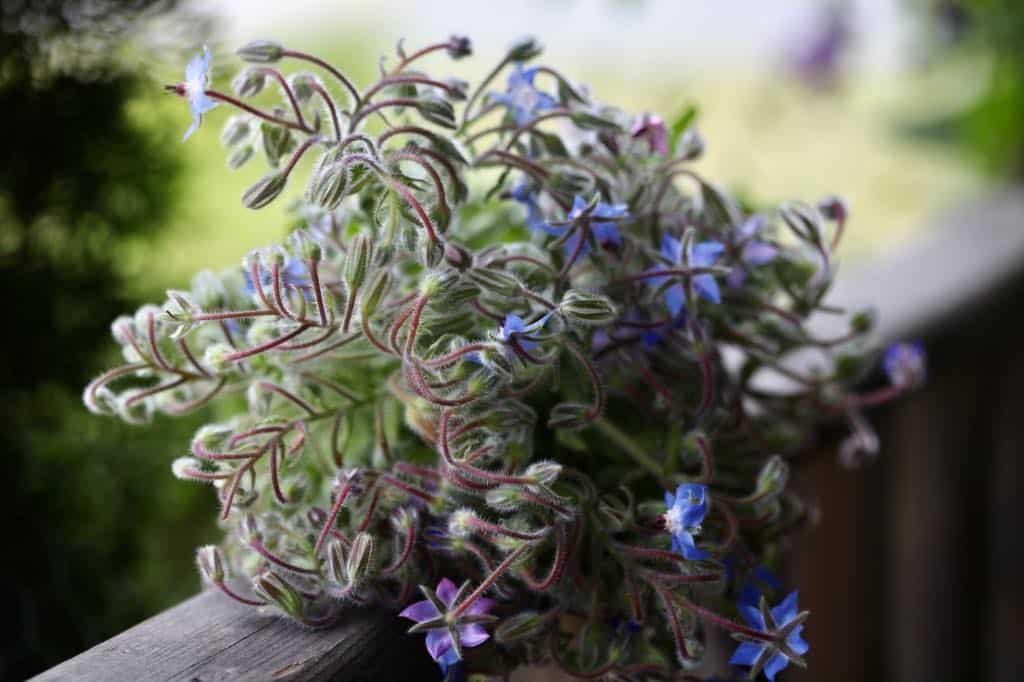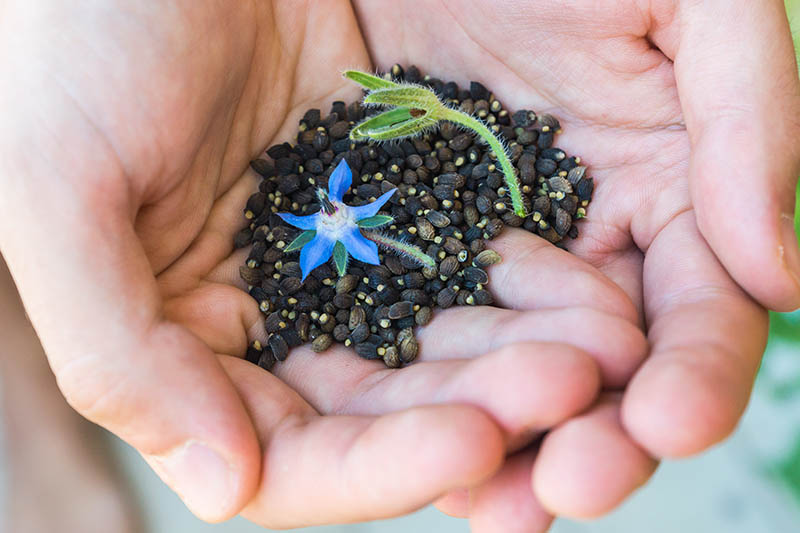Why Every Gardener Should Grow Borage
Borage, often called the starflower for its striking blue, star-shaped blooms, is one of the most rewarding plants you can grow in your garden. Not only is it visually captivating, but it is also edible, medicinal, and one of the best natural companion plants you can have. With its refreshing cucumber-like flavor, borage flowers add beauty and taste to salads, drinks, and desserts, while the leaves can be used like spinach or steeped into nutrient-rich tea.
For Canadian gardeners, borage offers even more: it is hardy, resilient, attracts pollinators like bees, and improves soil health. Despite these incredible qualities, borage remains underused in many gardens. This article will guide you step by step on how to grow borage from seed, care for it, and harness its many benefits.

This article will guide you step by step on how to grow borage from seed, care for it, and harness its many benefits.
What Is Borage?
Borage (Borago officinalis) is an annual or self-seeding perennial herb native to the Mediterranean but widely adaptable across North America. Its signature five-petaled blue flowers bloom continuously throughout the season, making it a reliable nectar source for bees and other pollinators. The plant itself is drought-tolerant, thrives in poor soils, and is remarkably easy to grow, making it an excellent choice for both beginner and experienced gardeners.
Beyond its beauty, borage has long been prized in herbal medicine. Its oil, extracted from seeds, is rich in gamma-linolenic acid (GLA), an omega-6 fatty acid known to support skin health, reduce inflammation, and ease conditions like rheumatoid arthritis and eczema. The plant also plays a functional role in the garden by repelling pests such as tomato hornworms while attracting beneficial insects.
Why Grow Borage from Seed?
Growing borage from seed is by far the most practical, cost-effective, and rewarding way to bring this star-shaped flower into your garden. Unlike buying mature plants, starting borage from seed allows you to experience the entire life cycle from germination to bloom while saving money and building a stronger, more resilient plant. Borage seeds germinate readily, usually within a week, and seedlings establish quickly in both garden beds and containers. Once mature, the plants are vigorous, highly adaptable, and will often self-seed generously, ensuring that your garden is filled with these vibrant blue blossoms year after year without much extra effort. For gardeners in Canada looking to enrich their soil, attract pollinators, and add edible flowers to their space, learning how to grow borage from seed is one of the simplest and most rewarding steps you can take.

Growing borage from seed is by far the most practical, cost-effective, and rewarding way to bring this star-shaped flower into your garden.
Some key reasons to grow borage from seed:
-
Accessibility: Borage seeds are widely available and inexpensive.
-
Adaptability: Seeds can be sown directly in the ground, in containers, or started indoors for transplanting.
-
Sustainability: Self-seeding makes borage a lasting investment in your garden’s ecosystem.
-
Versatility: You can grow borage alongside vegetables, in pollinator-friendly beds, or as a stand-alone ornamental.
How to Grow Borage from Seed
Choosing and Preparing Your Seeds
When learning how to grow borage from seed, the first step is selecting quality seeds. Borage seeds are easy to identify thanks to their unique, textured surface and bulbous tip. Always choose fresh, untreated seeds, as older or chemically treated ones can significantly reduce your germination rate. For best results, store borage seeds in a cool, dry, and dark place until you are ready to sow, since exposure to moisture or sunlight may cause them to lose viability over time. Proper storage ensures your seeds will sprout vigorously when planted, giving your garden a healthy start.
Soil Preparation
Although borage is known for thriving in poor soils, preparing the right foundation will make a noticeable difference in plant health and flower production. Borage prefers well-draining soil enriched with compost or organic matter to encourage strong root development. A slightly sandy loam is considered ideal, but this resilient plant will adapt to most garden conditions. What’s most important is avoiding compacted soil, as borage roots need to spread deeply and freely. Loosen the soil before planting, and if you are growing in containers, select a high-quality multi-purpose potting mix with good aeration.
Planting Depth and Spacing
The key to success when you plant borage seeds is depth and spacing. As a general rule, seeds should be buried at a depth of about three times their size—roughly 1 cm. You can sow them directly outdoors once the danger of frost has passed, or if you’d like an early start, begin indoors 3–4 weeks before your region’s last expected frost date. Because borage tends to sprawl as it matures, give each seedling room to grow by spacing them at least 30 cm apart. Proper spacing ensures that plants don’t compete for sunlight, water, or nutrients, leading to fuller growth and more abundant flowering.

The key to success when you plant borage seeds is depth and spacing. As a general rule, seeds should be buried at a depth of about three times their size, roughly 1 cm.
Germination and Seedling Care
Borage is a fast starter—seeds usually germinate within 5–10 days in warm, bright conditions. During this period, light is critical. Without adequate sunlight, seedlings may become leggy, fragile, and more prone to disease. If sowing indoors, position trays near a south-facing window or use grow lights to provide steady illumination. Once seedlings reach about 5–7 cm tall, thin them out or transplant into larger pots or outdoor beds to ensure each plant has enough space to thrive. Healthy spacing at this stage encourages stronger stems, better air circulation, and ultimately more resilient plants that will reward you with weeks of continuous blooms.
Transplanting and Hardening Off
If you’ve started borage indoors, harden off the seedlings before moving them outdoors. Gradually expose them to outdoor conditions over 7–10 days, starting with a few hours of indirect sunlight and extending the duration daily.
When transplanting:
-
Dig a hole the size of the seedling’s root ball.
-
Gently loosen the roots without tearing them.
-
Place the plant in the hole, backfill lightly, and firm the soil without compacting.
-
Water deeply to help roots establish.
Borage establishes quickly and requires minimal care once transplanted.
Companion Planting with Borage
One of the greatest reasons to grow borage is its value as a companion plant. It improves the growth, flavor, and resilience of nearby crops while attracting pollinators and beneficial insects.
Borage grows especially well with:
-
Strawberries: Enhances fruit flavor and attracts bees.
-
Tomatoes: Repels tomato hornworm and improves pollination.
-
Squash: Provides shade, attracts pollinators, and repels pests.
-
Cabbage family crops: Helps deter cabbage worms and adds biodiversity to brassica beds.
By planting borage strategically, you reduce reliance on chemical pesticides while boosting yields naturally.
Caring for Borage Plants
Sunlight and Watering
Borage prefers full sun but will tolerate partial shade. During the seedling stage, keep soil consistently moist but not waterlogged. Once established, borage is drought-tolerant and requires less frequent watering. Overwatering can cause yellowing leaves or root rot.
Fertilization
While borage grows in poor soils, it benefits from occasional feeding. A high-phosphorus organic fertilizer once a week encourages more blooms. Alternatively, let borage leaves break down as mulch, enriching soil naturally with potassium and calcium.
Pruning and Deadheading
Regularly snip off yellow or damaged leaves. Deadheading spent flowers prolongs blooming and encourages fresh growth. Mid-season pruning also promotes new foliage if you’re harvesting leaves for culinary use.
Common Pests and Problems
Like most plants, borage is not immune to pests. The most common issues include:
-
Aphids: These sap-sucking insects curl leaves and stunt growth. Wash them off with water or use neem oil spray.
-
Spider mites: Tiny red mites that leave white specks on leaves. In severe cases, they may kill plants. Neem oil or insecticidal soap helps control infestations.
-
Snails and earwigs: These may chew at the base of stems. Handpicking or using barriers can help protect young plants.
Despite these, borage often acts as a trap crop, drawing pests away from vegetables and concentrating damage on itself rather than your harvest crops.
Harvesting Borage
Harvesting Flowers
Pick borage flowers when fully open but still vibrant. Use them fresh for salads, drinks, and desserts, or freeze them in ice cubes for summer beverages.
Harvesting Leaves
Young borage leaves are tender and edible, though they develop fine prickles as they mature. Use them in salads, as spinach substitutes, or steep them into herbal teas rich in vitamin C, potassium, and calcium.
Harvesting Seeds
If growing borage for its medicinal oil, allow flowers to mature and form seeds. Collect seeds when pods dry and harden, storing them for replanting or processing into oil.

If growing borage for its medicinal oil, allow flowers to mature and form seeds. Collect seeds when pods dry and harden, storing them for replanting or processing into oil.
Medicinal and Culinary Uses of Borage
Borage has a long history in herbal medicine. Borage oil, derived from seeds, contains GLA—an essential fatty acid linked to anti-inflammatory benefits. Studies suggest it may help with arthritis, skin conditions, and hormonal imbalances.
Culinary uses are just as exciting. Borage flowers are edible, tasting faintly of cucumber, making them perfect for garnishing cocktails, desserts, or salads. The leaves can be cooked like spinach or used in soups and stews.
Why Borage Deserves a Spot in Your Garden
From its delicate, star-shaped blue blossoms to its practical role as a natural pest deterrent, pollinator magnet, and edible herb, the borage plant is without doubt one of the most versatile additions you can make to your garden. Few plants can offer so many benefits at once: continuous blooms that attract bees and butterflies, leaves that can be harvested like spinach, and flowers that bring both beauty and a refreshing cucumber-like flavor to drinks and desserts. Learning how to grow borage from seed is not only simple and cost-effective but also one of the most rewarding gardening experiences, ensuring you enjoy a plant that comes back season after season through self-seeding.
If you’re seeking a multipurpose herb that improves the flavor of nearby vegetables, supports the health of your soil, and fills your beds with vibrant color, borage is the answer. This is a plant that delights pollinators, boosts your strawberry and tomato harvests, and even offers medicinal uses through its nutrient-rich leaves and oil-rich seeds. Give borage in the garden a chance this season, whether in containers or garden beds—you may quickly discover that it earns a permanent place in your growing space, becoming not just a companion plant but a centerpiece of your gardening journey.
FAQs About Growing Borage
1. Is borage an annual or perennial?
Borage is typically grown as an annual, but it self-seeds so easily that it often behaves like a perennial.
2. Can borage grow in pots?
Yes, borage grows well in containers as long as they are deep enough for its taproot and have proper drainage.
3. How tall does borage grow?
Borage can reach up to 60–90 cm in height, with a spread of 30–45 cm.
4. Is borage safe to eat?
Yes, flowers and young leaves are edible. However, pregnant and breastfeeding women should avoid borage due to pyrrolizidine alkaloids.
5. When should I plant borage seeds in Canada?
Sow seeds outdoors after the last frost in spring, or start them indoors 3–4 weeks earlier for transplanting.
6. Does Borage Self-Seed?
Yes, perhaps too well. Borage readily self-seeds, making it a recurring presence in your garden once planted. While some gardeners appreciate its persistence, others prefer containing it in pots to prevent spreading. Thankfully, seedlings are easy to pull up if unwanted.
Call to Action
At DH Garden Centre in Vancouver, we believe every garden deserves the beauty and benefits of borage. Whether you’re starting from seed or looking for expert advice on companion planting, our team is here to help. Visit us in-store at 3742 West 10th Avenue, Vancouver, BC, or shop online for seeds, soil, and compost to start your borage journey today.


